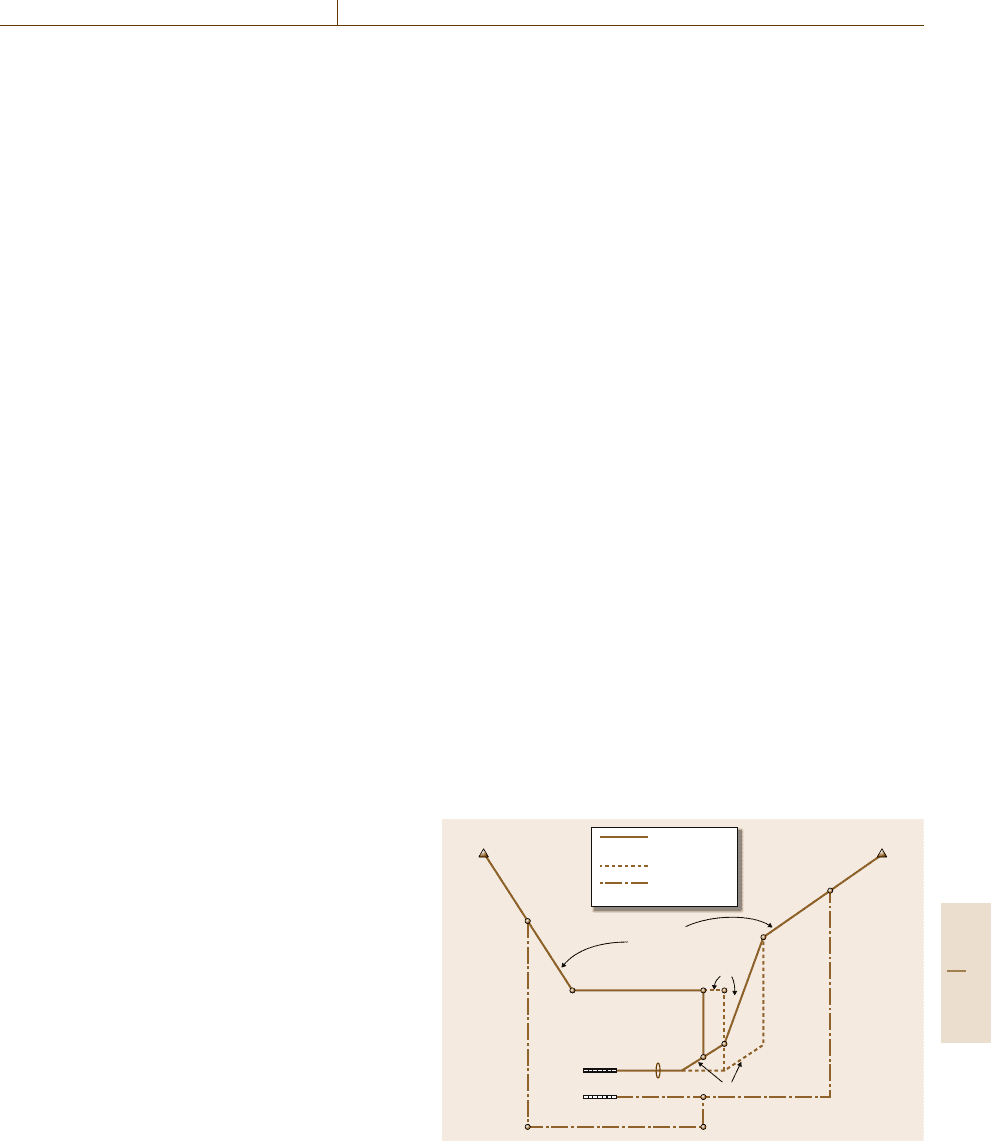Nof S.Y. Springer Handbook of Automation
Подождите немного. Документ загружается.


Air Transportation System Automation 67.5 Future Air Transportation System Requirements and Functional Automation 1205
lookahead horizon) in an operationally acceptable man-
ner, without introducing any new problems. The search
process examines, in turn, maneuvers in each of the fol-
lowing five dimensions/directions, thus yielding up to
five resolutions for that aircraft:
1. Select an altitude above the altitude of the problem
2. Select an altitude below the altitude of the problem
aircraft
3. Turn aircraft left of the route
4. Turn aircraft right of the route
5. Increase or decrease speed.
Each resolution requiresonly onemaneuver[67.19].
The completed PARR resolutions are ranked, color-
coded, and displayed on the URET plans display; for
example, conflicts predicted with violation of separa-
tion minima are coded red. This provides the controllers
with information to set priorities in dealing with the
problems. After the aircraft follow the resolution ma-
neuvers, and there is no more problem, the aircraft
return and continue on their original flight trajectory.
The PARR could also generate resolutions around haz-
ardous weather areas.
It is expected that the PARR function will signif-
icantly enhance safety. The safety enhancements are
important, since the relaxation of AT C restrictions in
the future could lead to more complex traffic patterns.
The PARR would assist in maintaining or enhancing
safety in twoways. First, thePARR provides anautoma-
tion capability with which the controllers can obtain an
improved, strategic situational understanding, e.g., by
quickly assessing which altitude, speed, or direct-to-fix
alternatives are problem free. Second, the resolutions
provided by PARR allow the controller to easily imple-
ment strategic, problem-free resolutions, which would
allow more time for decision-making and coordination
for handling other pilot requests.
Reducing Separation Minima
to Enhance Capacity
The airport capacity for a single runway depends upon
the weight-class-based wake vortex separations be-
tween successive aircraft in-trail on a final approach,
the length of the final approach to capture the ILS local-
izer, runway occupancy times, and a spacing buffer for
safety. For operations on parallel runways and routes,
the lateral separation depends upon the ability of the
aircraft to fly close to their desired path centerline.
The established IFR separation minima apply dur-
ing poor visibility (less than 3 nmi) and/or lower cloud
cover ceiling (less than 1000 ft). When the visibility and
the ceiling are higher than these conditions, the aircraft
fly VFR when the pilots are able to see other aircraft
and the runway before turning onto the final approach,
a situation called, see and be seen. For these visual op-
erations, the aircraft are observed to land with much
smaller separations than the established IFR separation
minima without compromising any safety, but yielding
a much higher capacity. This is because the aircraft are
not constrained by the required longer ILS straight-in
approaches and a fixed glide slope. Therefore, by fly-
ing shorter final approaches and variable glide slopes,
the aircraft encounter less impact of wake vortices, and
as such could use less in-trail separations. The follow-
ing future avionics technologies will help reduce the
current wake vortex separation minima by permitting
aircraft to operate as VFR under all weather conditions.
The required navigation performance capabilities in the
aircraft will support reduction of lateral separations be-
tween routes. A future terminal automation function
discussed later will reduce spacing buffers by reducing
the impact of flight uncertainties.
Aircraft Technologies
for Electronic VFR Operations
Although there have been no separation minima es-
tablished for the current VFR operations, there is
sufficient data available to define them, if the air-
craft could operate like VFR during IFR conditions.
The following technologies will help pilots operate as
VFR at night and during poor weather and visibility
conditions.
Using ADS-B information from the aircraft in the
vicinity of the subject aircraft, the CDTI displays the
position of other aircraft on a screen in the cockpit.
The head-up display (HUD) is mounted on the aircraft
instrument panel below the windshield to monitor the
external environment (aircraft and airport). The HUDs
provide microwave and infrared (IR) images to the pi-
lots. The use of these wavelengths allows pilots to see
the runways in poor visibility by penetrating fog or
other adverse weather conditions. The enhanced vision
system (EVS) enhances a pilot’s situational awareness
during approach andlanding, when thevisibility is poor,
using an IR camera displaying a picture of the surface
below.
The synthetic vision system (SVS), with its ability
to let pilots see terrain, obstacles, and runways in poor
visibility conditions, is designed for use by high-end
business jets for situational awareness and safety. A 3-D
view allows the pilots to see rendering of terrain ahead
using information from onboard obstacle, terrain, and
Part G 67.5

1206 Part G Infrastructure and Service Automation
Containment limit (CL) = 2×RNP X
Containment limit (CL)
Cross track containment limit =
probability TSE > CL less than
10
-5
/flight hour
Comprises navigation system error,
computational error, display error,
course error and flight technical error
RNP X value
aircraft within bounds
95% of flight time
TSE
Containment
region
Containment
value
Desired path
Fig. 67.12 Required navigation performance (RNP) concept
airport databases and tracked flight path. The naviga-
tion display shows the intended aircraft flight path with
a view that provides real position over the terrain with
respect to the flight plan.
Required Navigation Performance
In order to reduce the requirement for lateral separa-
tion between aircraft on parallel routes, or to conduct
simultaneous approaches to closely spaced parallel run-
ways, the aircraft would need to have a RNP capability.
The RNP enablesaircraft notonly tofly RNAV point-to-
point, but also to stay within certified route containment
limits with an onboard monitoringand alerting function.
This function enhancesthe pilot’s situational awareness,
and alerts the pilot when there is a gross deviation from
the route centerline, thereby permitting closer route
spacing without ground ATC intervention.
Figure 67.12 shows the RNP concept and the lat-
eral components of the aircraft navigational error. The
RNP is a measure of navigation performance accu-
racy and integrity (i.e., route containment and time to
alarm) necessary for aircraft operations within a defined
airspace. As shown in the figure, an aircraft certified
for a given RNP value, e.g., RNP X,mustnavigate
with a total system error (TSE) not to exceed 2X nmi
with a probability of 10
−5
per flight hour, defined as
the cross-track containment limit. When exceeding this
limit, the monitoring function will generate an alert
for the pilot to correct back to the desired course. The
RNP X value defines the bound of lateral deviation with
a probability of 95% of flight time.
The TSE is the deviation of the aircraft’s true po-
sition from the desired course or the centerline of the
route of the flight path programmed in the FMS. The
TSE is a combination of errors from the following con-
tributing factors:
•
Navigation system error
•
RNAV computation error
•
Display system error
•
Course error and flight technical error (FTE).
The airborne equipment accounts for data and com-
putational latencies, equipment response time, and
navigation sensor error characteristics for its interfaces.
The TSE value assumes a flight director or an au-
topilot operation that allows the use of either GPS or
DME/DME as navigation sources for position determi-
nation. The aircraft are capable of RNP 0.3aidedby
a flightdirector inthe aircraft,and RNP 0.11 with a cou-
pled highly accurate automatic flight control system
(AFCS). The en route path lateral separation require-
ment could be reduced to 4nmi from the current 8 nmi
for aircraft with RNP 1. RNP 0.11 would permit in-
dependent parallel runway operations with significantly
reduced runway spacing.
Automation Functions
to Improve Flight Efficiency and Reduce Delays
Probabilistic Traffic Congestion Management. The
current TFM function balances air traffic demand
against airspace constraints and airport capacity tak-
ing into consideration the forecasted weather condi-
tions [67.20]. A variety of flow control actions are used
to deal with the airport capacity constraints. These in-
clude weather avoidance routes, miles in-trail (MIT)
restrictions to deal with traffic congestion at fixes
and the ground delays generated by the ground de-
lay program to establish expected departure clearance
times (EDCT) for flights. Planning for these actions
requires predictions of both the traffic demand and
the airspace (sector) capacity. Since the TFM deci-
sions are typically made 30min to several hours in
advance of the anticipated congestion, these predic-
tions are subject to significant uncertainty. However,
the magnitude of this uncertainty is not known, pre-
sented, or understood. As a result, traffic management
decisions are often overly conservative, and may be
taken at inappropriate times depending upon the accu-
racy of prediction data. Thetraffic demand uncertainties
arise from many sources. The flight schedules un-
dergo constant changes in response to daily events,
and such changes often occur between the time of de-
mand prediction and the time for which demand is
predicted. These include flight cancelations, departure
time changes, and initiation of previously unscheduled
Part G 67.5

Air Transportation System Automation 67.5 Future Air Transportation System Requirements and Functional Automation 1207
flights. This latter category is increasing in the USA, as
air taxi and executive jet operations are becoming more
prevalent.
Several new techniques and technologies are re-
quired to provide probabilistic TFM decision support.
First, prediction uncertainty must be known and quan-
tifiable. Second, a metric is needed for rating the
goodness of the candidate solutions. Third, decision-
making algorithms are needed to develop congestion
management solutions, given the prediction uncertainty
and the goodness metric. Finally, there are significant
human factors issues to be resolved due to the combina-
tion of information uncertainty and complex automated
processes.
Effective TFM decision making in the presence of
uncertainty or probabilistic TFM, should have the fol-
lowing characteristics:
1. Rather than attempting to resolve all possible con-
gestion problems, incremental actions are taken to
keep traffic congestion risk at an acceptable level,
while retaining flexibility to take further actions as
the situation becomes more certain
Departure planning and the
minimization of taxi times
requires coordination bet-
ween all of these stakeholders
and information on flights
15–30 minutes prior to push-
back untill take-off
Knowledge of real-time
flight position after push-
back improves accuracy of
recommended plans
Accurate prediction of push-back times is key
factor in efficient ground movement planning
Taxi clearance
Take-off clearance
Wheels-off
Departure queuing
ARTCC
TMU: Issue
Update status
and
push-back
clearance
Ramp
control
tower
Airport
terminal
Gate
Ramp area
TMU:
Issue
TFM initiatives
TFM initiatives
To host computer:
Issue or amend
Flight plan
Update airport
operational status info
Update active runways
and configuration
TRACON
AOC
ATCT
Fig. 67.13 Required coordination during departure process
2. Predicted traffic congestion areas are continually
reevaluated for further control action
3. NAS users are informed of predicted congestion,
so that they can proactively reduce schedule risk
if desired (e.g., by replanning flights through less
congested airspace)
4. Probabilistic congestion predictions are presented
to traffic planners and users in an intuitive way, in
order to maintain good situation awareness.
Multicenter Traffic Management Advisor. The TMA
function implemented in the en route automation host
computer systems (HCS) regulates or meters traffic ar-
riving from different directions within a single ARTCC
to a major airport. The development of multicenter
traffic management advisor (McTMA)ledbyNASA
is being built upon the TMA hardware and software
baseline. The McTMA is an automation decision sup-
port function, which extends time-based metering from
a single ARTCC/single airport arrival traffic flow plan-
ning to multi-ARTCC operations dealing with traffic
flow problems at critical bottlenecks in the en route
Part G 67.5

1208 Part G Infrastructure and Service Automation
airspace and merging of departure traffic with over-
flights. This function employs a distributive scheduling
algorithm to develop flexible collaborative metering
plans taking into consideration the AT C constraints at
airports and in the en route/transition airspace spread
across a region comprising a number of ARTCCs. The
distributed scheduling provides a dynamic look-ahead
capability and a provisional landing slot reservation sys-
tem to continuously monitor and feedback upstream
adjustment of flight times. This is required to deal
with demand/capacity imbalance at the point of conges-
tion [67.21].
Departure Planning and the Role of Airport Sur-
face Automation.
Most of the traffic flow management
constraints are applied at the airports when the traffic
demand exceeds either the en route capacity or the ca-
pacity at the flights’ destination airport. Consequently,
these restrictions are imposed on departing flights so
that a particular flight departs at a specific time in order
to fit into a specific place in the stream of traffic, or to fit
into a specific arrival time slot at the destination airport.
The management ofthese departuretime constraintscan
make the airport surface air traffic control task much
more complex. A surface automation function is needed
to take all of these constraints into account for efficient
departure planning. The airport surface automation sys-
tem will also help reduce airport accidents, although
small in number (13 from 1997 to 2007), by provid-
ing timely andaccurate information onaircraft positions
both to the ground system and the cockpit.
Figure 67.13 illustrates the exchange of informa-
tion between the various facilities to manage departing
flights in order to use capacity at major airports effec-
tively. The airport ramp control tower provides each
aircraft with a clearance to push back fromthe gate. The
desired airport runway configuration to use is given by
the tower, so that each departing flight could exit the
ramp at an appropriate time. The ATCT is responsible
for providing clearances for the aircraft to taxi safely
from the ramp area to the departure runway, and to
take off at appropriate times so as to meet all traffic
flow constraints and safe separation requirements. The
TRACON provides the AT CT with the relevant traf-
fic flow constraints upstream, as does the ARTCC. The
AOC provides the initial flight plan and manages the
dispatch of each flight under its control.
The airport departure capacity is a function of the
sequencing of flights to each departure runway. Aircraft
in the heavy weight class require more spacing behind
them than smaller aircraft. Therefore, clustering heavy
aircraft together could significantly increase runway ca-
pacity. Dynamically managing arrivals and departures,
by building extra arrival runway slots when necessary to
absorb extra arrival demand, also improves the overall
effective use of airport capacity.
In order to facilitate all of the above interrelated de-
cisions, the airport surface automation system should
provide the following four functions, and the informa-
tion generated must be provided in real time to all of the
decision-makers shown in Fig.67.13:
•
Surface aircraft and vehicle surveillance
•
Automated transfer of controller clearance and
flight intent information
•
Detection of potential airport surface conflicts
•
Automation decision support function to assist the
ramp control tower and the ATC T to best use the
available runway and taxiway capacity.
Surface aircraft and vehicle surveillance, as well as
the automated clearance and intent information trans-
fer, are the two key functions that enable the other two
functions listed above. Information about the current
position of each aircraft and the vehicle located on an
airport’s taxiways and runways, integrated with the po-
sitions of the aircraft immediately around the airport,
provide the AT CT and the ramp control tower with the
ability to see all of these objects, even when the physi-
cal line of sight is obstructed by low airport visibility
conditions (fog). They also provide the necessary in-
put tothe surface conflictdetection function,which uses
the known positions of each aircraft and vehicle and in-
fers the future path of each aircraft and vehicle (e.g., the
cleared taxi path), in order to detect potential conflicts.
When a conflict is predicted, the automation function
generates an alarm for the controller to alert the pilot to
take an action to avoid the conflict.
The surface automation decision support function
provides the traffic flow managers and the air traffic
controllers inthe ATC T and theramp control tower with
recommendations on actions such as:
•
When to change the runway configuration to mini-
mize the loss of capacity during the changeover
•
In what order to best maximize the taxiing aircraft
movement through the exit spots at the edge of the
ramp area
•
In what orderto bestqueue aircraft tomaximize run-
way capacity given the traffic constraints, the size of
the aircraft, and other factors
•
How best to introduce arrival slots between the
departure slots to minimize arrival and departure
delays.
Part G 67.5

Air Transportation System Automation 67.5 Future Air Transportation System Requirements and Functional Automation 1209
The approaches to develop these automated deci-
sion support functions have already been discussed in
detail [67.22,23].
Terminal Automation for Arrival Planning and Con-
trol [67.24].
Over the years, two terminal automation
functions, viz. metering and spacing (M&S) and the
final approach spacing tool (FAST), were developed
and went through extensive validation and field testing.
However, these functions were not accepted by con-
trollers, because the automation-generated information
was either too constraining or inconsistent with the hu-
man decision process. These functions were intended
to complement en route metering function (TMA)to
accurately establish landing sequences and times to en-
hance airport capacity. The crux of the problem was
a discrepancy between the TMA-planned nominal flight
trajectories and the actual trajectories flown by aircraft
tactically changed by TRACON controllers to achieve
desired separations between aircraft.
The TMA establishes desired meter fix times for
the traffic going to an airport while they are still in
the en route airspace by establishing landing sequences
and times based on prestored aircraft trajectory data
and wind information over the terminal airspace. The
en route controllers try to meet these meter fix times
within a specified tolerance (1min) by maneuvering the
aircraft before they reach the meter fixes. Once the air-
craft enter the terminal airspace, theterminal controllers
merge traffic generally coming from four different di-
rections to maintain the required separations, as well as
guide the unequipped aircraft in the terminal maneuver-
ing areas, if there are no navaids. As such, they end up
changing the en route metering system planned paths
and landing time schedules. This affects the flight plan-
ning and operational efficiency for aircraft all the way
to touchdown by first getting delayed in the en route
airspace and then getting further delayed in the terminal
area.
A terminal automation arrival planning and control
function is needed to complement the en route planning
function in order to predict arrival schedules accurately.
This is essential for realizing maximum efficiency ben-
efits for the users by flying optimum paths, and for
the service providers to manage diverse aircraft traffic
with minimum air–ground communications. This func-
tion should minimize the variations between the aircraft
flight planning and actual operations by first defining
routes all the way to touchdown and then establishing
landing sequences and schedules using accurate flight
time estimates.
The basic requirement for establishing an efficient
terminal area flight planfor each aircraftis that itshould
be based on minimum flying time from the entry (me-
ter) fix to the runway. In order to achieve the earliest
permissible landing times:
1. The plans should be based on the shortest paths
2. Continuous descent from meter fixes to touchdown
3. The aircraft are assumed to fly highest permissible
speeds over each flight segment
4. The routes from different directions towards final
approach (s) are adequately separated to avoid con-
flicts during merging of traffic
5. The landing times for successive aircraft ensure
adequate separations based on wake vortex consid-
erations.
Once the landing times are established, they should
be integrated with the en route planning of flight times
such that, when the aircraft arrive at the meter fixes
within a desired tolerance, they should be able to con-
tinue on the established 3-D profiles without any need
for pathdeviationsto maintainseparations. The en route
metering process ensures delivery of aircraft at the me-
ter fixes within the expected time variance.
In most major terminal areas today, the aircraft,
using four-corner post configuration, navigate over
established STARs from the meter fixes to about
10–15nmi radial distance from the airport. Depend-
ing upon the direction of arrival, the aircraft either fly
a downwind path and then turn onto a base leg, or turn
directly onto the base leg, before intercepting the fi-
nal approach as shown in Fig.67.14. Since there are
mostly no established routes in the base-leg region, the
250 kt
Speed 1
Speed 2
Speed 1
Downwind path
Routes based on
location of navaids
Final
approach
OM
2.5 nmi
2 nmi
30° localizer intercept
STAR
STAR
Meter fix 1
250 kt
Meter fix 2
3nmi
separation
for problem
free planning
Path to
changed
runway
Path to
changed
runway
Base leg
approach
speed
5 nmi
Base
leg
Speed 2
Inner fix 1
Inner fix 1
Desired
shortest path
Delayed path
New path with
runway change
Fig. 67.14 Terminal merge-free route design for flight planning,
with permission from IEEE
Part G 67.5

1210 Part G Infrastructure and Service Automation
controllers merge the traffic coming from the opposite
directions over the two base legs, and then again merge
the traffic flying over the two base legs from the op-
posite directions onto the final approach to a single
runway. Merging of aircraft at two or three points, while
keeping them separated, results in inefficient, large path
deviations and significant workload for both the pilots
and the controllers.
In order for most of the aircraft to stay on the min-
imum path for maximum flight efficiency with short
delays, aircraft-derived speed control should be used
as the primary means to compensate for aircraft per-
formance deviations and wind forecast uncertainties. In
order to achieve this, the terminal route design should
eliminate the need for the controllers to merge traffic
at multiple points except on the final approach(es). As
such, the routes should not only be the shortest, but
all merge points should also be eliminated. As shown
in Fig.67.14, the aircraft arriving from the direction
opposite to the direction of landing (meter fix 1) fly
a downwind path from the end of the STAR turning
onto a base leg 5nmi long before intercepting the lo-
calizer course. For smooth capture of the localizer, the
aircraft intercept the final approachcourse at an angleof
30
◦
or less over a path segment of 2.5 nmi to allow for
smooth turns from the base leg to the localizer course.
The aircraft also need to capture the localizer for final
approach course about 2nmi from the outer marker in
order to be stabilized over the glide slope to the runway.
This defines the minimum path in the base-leg region.
The aircraft arriving from the other direction (meter
fix 2) turn directlyonto the base leg before capturing the
localizer course. In order to create a merge-free route
design, the base legs are separated by 6 nmi to keep the
aircraft not only safely separated when arriving from
differentdirections, but alsoto allow for some margin of
airspace todeal with pop-up aircraft, missed approaches
or large aircraft deviations (as shown dotted in the fig-
ure). A mirror image of thedesign in Fig. 67.14 could be
applied to the other two fixes, either to the same runway
or to a parallel runway. The figure also shows a path
in case the runway assignment is changed. In the fu-
ture, if some other than ILS precision landing guidance
is available, the base-leg and final approach paths could
be shortenedfor curved approachescustomized for each
aircraft depending upon its avionics capabilities.
After entering the terminal area, most aircraft are
required to reduce speed to 250kt before they attain
an altitude of 10 000ft. From there on, depending upon
the aircraft performance characteristics, the aircraft typ-
ically go through two speed reductions (speed 1 and
speed 2 in Fig.67.14) before reducing to their final
approach speeds. The automation function could deter-
mine timing or location of these speed reductions to
compensate for flight time variances from the desired
landing times without requiring the aircraft to divert
from the above-defined minimum paths.
The NextGen concept for the future air transporta-
tion system considers 4-D navigation as one of its core
elements. In order for the aircraft to operate in a 4-D-
navigation mode, a 3-D flight profile is established from
take-off to landing with estimated times of arrival at key
decision points along the path. The aircraft are required
to stay on the predefined 3-D paths and meet the times
at these points by adjusting speeds along the flight seg-
ments using the onboard required time of arrival (RTA)
function with automated thrust management. Because
of the time compression at the end of flight during the
arrival/landing phase, any path deviation along the way
would be counter to the goals of 4-D navigation.
Air/Ground Automation with Aircraft
Self-Separation to Reduce Workload
Air traffic controllers today are involved in a number of
routine ground–air communications, such as changing
frequency, when the aircraft transition from one con-
troller airspace to another’s. In the future, the ground
automation system will directly communicate routine
information over a data link to the aircraft FMS.Inad-
dition, the primary responsibility of the controller to
separate aircraft could be shared with the appropriately
equipped aircraft, which could self-separate under cer-
tain situations as discussed below. The increased use of
automation both in the ground system and in the air-
craft cockpit will help reduce workload for both the
controllers and the pilots.
Before aircraft are committed to the final approach,
the controllers direct the aircraft to maintain specific
in-trail spacing when following each other, or when
the aircraft merge from different directions on a com-
mon point in airspace, and then follow each other in
a single stream of traffic. This process requires a se-
ries of clearances, as well as monitoring of aircraft
conformance to the directions from the ground. This
is workload intensive for both the pilots and the con-
trollers. In the future, with the aircraft equipped with
ADS-B, CDTI, FMS,andRNP, including a monitor-
ing and alerting capability, the aircraft will have the
ability to maintain separation from other equipped air-
craft. Flight-deck-based merging and spacing concepts
are being explored in which a strategic setup is estab-
Part G 67.5

Air Transportation System Automation 67.6 Summary 1211
lished by the ground system followed by cockpit-based
self-separation [67.25].
NASA has defined an automated airspace concept
that uses ground-based automated airspace computer
system (AACS) to generate conflict-free air traffic con-
trol advisories and send trajectories via a two-way
data link to the FMS of equipped aircraft. With traf-
fic situational awareness provided by CDTI, the pilots
could assume separation assurance responsibility dur-
ing certain traffic conditions. Although the selection
of data link and data transmission protocols to meet
these requirements is uncertain at this time, mode S,
ADS-B, and VDL2 are likely candidates for this con-
cept. The automation of separation assurance function
will also mitigate a number of AT C constraints that
limit the efficiency and capacity of the current ATM
system [67.26].
The joint FAA/Eurocontrol Cooperative Research
and Development Committee defined the principles
of operation for the use of airborne separation as-
surance systems (ASAS) taking into account US and
European perspectives for global applications [67.27].
The primary guiding principle is based on cooper-
ative involvement of both the pilots/aircraft systems
and the controllers/AT M system in assuring separation
among aircraft. Four specific ASAS applications de-
fined are:
1. Airborne traffic situational awareness to enhance pi-
lots’ knowledge of surrounding traffic
2. Airborne spacing to permit pilots to maintain
a given spacing with designated aircraft
3. Airborne separation when the controller delegates
separation assurance responsibility to the pilots
4. Airborne self-separation when the pilots achieve
separation from other aircraftin accordancewith the
desired separation standards and rules of flight.
These concepts make use of aircraft capabilities-
based performance to establish different control mecha-
nisms for different segments of airspace. The equipped
aircraft assume responsibility for self-separation and for
monitoring and alerting in most airspace, except where
there are high-density traffic operations. Most FMS us-
ing GPS for navigation alert the pilots when navigation
performance exceeds RNP criteria. This UNABLE RNP
alert is based on probability and not on measured error,
and is only a part of therequired monitoringand alerting
process. Aflight technical error relative tothe computed
path is displayed to the pilot for monitoring lateral and
vertical deviations. A corrective action is required if ei-
ther the lateral or vertical deviation exceeds the lateral
RNP limit, or 75ft in vertical, respectively. The GPS
meets the monitoring and alerting requirements of ac-
curacy and integrity through RAIM alerts tied to the
RNP value for each phase of flight. This means that
the separation assurance responsibility is ground based
in the airspace where the traffic density and flight un-
certainties are high, whereas some separation assurance
responsibility could be delegated on a pairwise basis to
aircraft during light traffic. In other airspace segments,
both the aircraft and the ground automation share re-
sponsibilities, with the aircraft responsible for tactical
flow management and separation assurance, while the
ground system is responsible for strategic traffic flow
management.
67.6 Summary
The current US air transportation system has an excel-
lent record for safety of aircraft flying in accordance
with the IFR separation requirements. The NAS relies
on VHF for voice communication between the pilots
and the air traffic controllers, ground-based VOR/DME
systems for navigation, primary and secondary radars
for surveillance, and ground-based automation for flight
and radar data processing at local, regional, and na-
tional AT C facilities. During 2006, over 700 million
passengers flew in the NAS, and the cargo revenue
ton miles exceeded 40billion. The NAS manages about
55000 operations daily, with about 6500 flights in
the air during peak demand. The density of traf-
fic is creating congestion at airways and airports,
thereby creating bottlenecks resulting in flight delays,
which cost the airlines millions of dollars in lost
revenue.
With the demand for air traffic services continu-
ing to increase, future delays will increase significantly
unless the NAS is transformed. Satellite-based CNS
technologies offer the opportunities to enhance safety,
airport capacity, and flight efficiency. The new genera-
tion ofaircraft has already acquired avionics compatible
with satellite-based CNS technologies, with increased
automation provided by the FMS. However, the ground
system infrastructure needs to be modernized using
Part G 67.6

1212 Part G Infrastructure and Service Automation
satellite-based CNS technologies and automation of de-
cision support functions.
This chapter describesthe currentCNS andATM in-
frastructure, which includes VHF/HF communications,
ground-based navigation systems, viz. VOR, DME
and ILS, and primary/secondary radars for surveil-
lance. Upcoming satellite-based CNS technologies are
also discussed, e.g., VHF data link for data commu-
nication, GPS/WAAS for navigation, and ADS-B for
surveillance. How these technologies will enhance air-
craft operations with direct air/ground communications,
RNAV point-to-point navigation, and improved aircraft
tracking for automated decision support is elaborated in
order to provide an understanding of the major techno-
logical transformation expected in future NAS.
The functional role of automation in the aircraft and
the ground system is addressed in terms of their limited
use today, as most of the decisions in the cockpit and
on the ground are human-centric. The two major func-
tions of the AT M system in NAS,viz.TFM and AT C,
and their limitations are addressed. Most of the automa-
tion functions such as MSAW/conflict alert/URET are
primarily used for aircraft safety. Limited automation
functional capabilities exist, such as TMA and ETMS,
to deal with capacity, flight efficiency, and workload,
although a number of newer aircraft have FMS to help
aircraft fly efficiently.
The metrics to measure CNS/AT M systems’ per-
formance are aircraft safety, airport capacity, flight
efficiency with its impact on delays, and pilot/controller
workload. The established government regulations re-
quire the aircraft to follow other aircraft with specific
separation distance minima in various phases of flight.
Because of human decision making, the controllers of-
ten plan for larger than the required IFR separation
distance rules to ensure safety, although this adversely
affects capacity, resulting in increased delays and work-
load. A detailed explanation of the factors used in
defining the above performance measures is provided
here to develop a clear understanding of the CNS/ATM
system operational elements that the new technologies
should improve, and the functions which should be
automated for the air transportation system of the fu-
ture.
This chapter also provides highlights of the future
CNS/AT M capabilities for the NextGen system for the
year 2025 and beyond, with its goals and objectives.
How the enhanced automation could meet the require-
ments of the future system for increased safety and
capacity, as well as for reducing delays and workload,
is also discussed.
In order to realize some of the goals of the fu-
ture air transportation system, research is going on
to develop new capabilities such as RNP, CDTI,and
EVS in the cockpit, and automated functions such as
PARR, McTMA, probabilistic TFM, and automated de-
parture/arrival management for the ground-based AT M
system. The new aircraft technologies will provide the
aircraft with an ability to operate in poor-visibility
conditions just like they operate in good-visibility
conditions to reduce separation minima and increase
capacity. The enhanced automation in the cockpit and
in the ground system will be better able to deal with
the system uncertainties to improve flight efficiency and
reduce delays, as well as provide both the pilots and
the controllers with accurate and timely decisions to
help reduce their workloads. Moreover, some sharing of
separation assurance responsibility between the pilots
and controllers would result in equitable distribution of
workload for ensuring safety of flights.
Because of the limited space here to cover the vast
scope of the current air transportation system functions
and capabilities and ongoing research to develop the fu-
ture system, this chapter provides a tutorial at a high
level. For specific details of any feature of the current
or future systems, it is recommended that the readers
seek information on the US FAA or the ICAO websites
(www.faa.gov or www.icao.int), respectively.
References
67.1 FAA: Aerospace Forecasts: Fiscal Years 2007–2020
(US Department of Transportation, Federal Aviation
Administration Policy and Plans, Washington 2007)
67.2 S. Kahne, I. Frolow: Air traffic management: Evolu-
tion with technology, IEEE Control Syst. 16(4), 12–21
(1996)
67.3 T.S. Perry: In search of the future of air traffic
control, IEEE Spectrum 34(8), 18–35 (1997)
67.4 M.S. Nolan: Fundamentals of Air Traffic Control,4th
edn. (Thomson Brooks Cole, Florence 2004)
67.5 ICAO: Standards and Recommended Practices,
Aeronautical Radio Frequency Spectrum Utiliza-
tion, Annex 10, Vol. 5 (International Civil Aviation
Organization, Montreal 2001)
67.6 S.C. Mohleji, P.J. Wroblewski, M.J. Zeltser: Capa-
bilities of the VOR/DME Navigation System for Civil
Aviation Report DOT/FAA/RD-82/74 (US Department
of Transportation, Federal Aviation Administration,
Washington 1992)
Part G 67

Air Transportation System Automation References 1213
67.7 M.C. Stevens: Secondary Surveillance Radar (Artech
House, New York 1988)
67.8 M.J. Burski, J. Celio: Restriction relaxation experi-
ments enabled by URET a strategic cloning tool, 3rd
USA/Europe ATM R&D Semin. (Naples 2000)
67.9 D. Knorr, J. Post, M. Walker, D. Howell: An oper-
ational assessment of terminal and en route free
flight capabilities, 4th USA/Europe ATM R&D Semin.
(Santa Fe 2001)
67.10 FAA: Air Traffic Control (US Department of Trans-
portation, Federal Aviation Administration, Wash-
ington 2006), Order 7110.65R
67.11 FAA: Aeronautical Information Manual (US Depart-
ment of Transportation, Federal Aviation Adminis-
tration, Washington 2007)
67.12 Boing: Statistical Summary of Commercial Jet Air-
plane Accidents, Worldwide Operations 1959–2006
(Boeing Commercial Airplanes Company, Chicago
2007)
67.13 FAA: Air Traffic Quality Assurance (US Department
of Transportation, Federal Aviation Administration,
Washington 2002), Order 7210.56C
67.14 A.L. Haines: Parameters of Future ATC Systems Re-
lating to Airport Capacity/Delay MTR 77W0000066,
Rev. 1 (MITRE Corporation, McLean 1978), FAA-EM-
78-8A
67.15 W.J. Swedish: Upgraded FAA Airfield Capacity
Model, Supplemental User’s Guide, Vol. I (MITRE
Corporation, McLean 1981), MTR-81W16
67.16 E.S. Stein: Air Traffic Controller Workload; An Ex-
amination of Workload Probe (US Department of
Transportation, Federal Aviation Administration,
Atlantic City 1985), DOT/FAA/CT-5N84/24
67.17 B. Sridhar, K.S. Sheth, S. Grabbe: Airspace
Complexity and its Application in Air Traffic Man-
agement, 2nd USA/Europe ATM R&D Semin. (Orlando
1998)
67.18 Joint Planning & Development Office: Next Genera-
tion Air Transportation System, Integrated Plan, (US
Department of Transportation, Washington 2004)
67.19 D.B. Kirk, M.S. Heagy, M.J. Yablonski: Prob-
lem resolution support for free flight operations,
IEEE Trans. Intell. Transp. Syst. 2(2), 72–80
(2001)
67.20 C. Wanke, L. Song, S. Zobell, D. Greenbaum, S. Mul-
gund: Probabilistic congestion management, 6th
USA/Europe Semin. Air Traffic Manag. R&D (Balti-
more 2005)
67.21 T.C. Farley, S.J. Landry, T. Hoang, M. Nickelson,
K.M. Levin, D. Rowe, J.D. Welch: Multi-center traf-
fic management advisor: Operational test results,
AIAA 5th Aviat. Technol. Integr. Oper. (ATIO) Conf.
(Arlington 2005)
67.22 W.W. Cooper, S.C. Mohleji, C. Burke, J.G. Foster,
M. Mills: DEPARTS: A tool for improving airline de-
parture scheduling and reducing flight delays at
busy airports. In: Handbook of Airline Strategy,ed.
by G.F. Butler, M.R. Keller (McGraw-Hill, New York
2001) pp. 577–600
67.23 W.W. Cooper, E. Cherniavsky, J. DeArmon, J.G. Fos-
ter, M. Mills, S.C. Mohleji, F. Zhu: Determination
of minimum push-back time predictability needed
for near-term departure scheduling using DEPARTS,
4th USA/Europe ATM R&D Semin. (Santa Fe 2001)
67.24
S.C. Mohleji, R.K. Stevens: Optimizing flight paths
for RNP aircraft in busy terminal areas – First step
towards 4-D navigation, 25th Digit. Avion. Syst.
Conf. (DASC) (Portland 2006)
67.25 W.J. Penhallegon, R.S. Bone: Evaluation of a flight
deck-based merging and spacing concept on en
route air traffic control operations, 7th USA/Europe
Air Traffic Manag. R&D Semin. (Barcelona 2007)
67.26 H. Erzberger: The automated airspace concept, 4th
USA/Europe Air Traffic Manag. R&D Semin. (Santa Fe
2001)
67.27 FAA/Eurocontrol Cooperative R&D: Action Plan 1:
Principles of Operation for the Use of Airborne
Separation Assurance Systems (Federal Aviation
Administration, Paris 2001 )
Part G 67
“This page left intentionally blank.”
